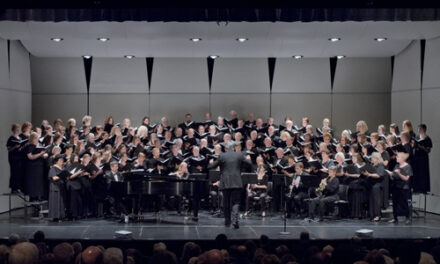Before an unusually large audience in Wright Auditorium, the East Carolina University Symphony Orchestra demonstrated fully that it is more than just a student ensemble. Over the past two to three years, the group of performers and caliber of performances have been on an upward trajectory, and the opening concert of the 2011-12 Season was highlighted by an ensemble that showed considerable musical skill from start to finish. And when joined by an outstanding soloist, this became a program to savor.
Subtitled “Deuces,” the program consisted of two works written in the first two years of the 20th century: Jean Sibelius’ Symphony No. 2 in D, Op. 43 (1902), and Sergei Rachmaninoff’s Piano Concerto No. 2 in C-minor, Op. 18 (1901), with ECU keyboard faculty member Benjamin Hochman as soloist. While nearly everyone knows the concerto, not everyone is familiar with the Sibelius symphony, although it might be the composer’s best known, and its conclusion is one of the grandest in the repertoire.
Sibelius’ symphony is the kind of work that often doesn’t seem to go anywhere, at least in the traditional sense — one gets the impression of a lot of terrific music in search of a single direction — but the journey is quite satisfying, containing interesting orchestral composition, ensemble combinations and instrumental techniques. Overall, the work is filled with tension and drama, growing out of a pastoral-sounding opening “allegretto” movement, with a lilting little dance built on rich strings, winds and horns. The ECU players gave this opening movement a strong, cohesive sound, especially in the strings. The second “tempo andante, ma rubato” movement opens with timpani and plucked basses (an example of interesting ensemble combination), joined by cellos, and builds in intensity with a fine brass crescendo. Before the movement ends, one feels the same kind of tension that developed in the first section.
The third and fourth movements, “vivacissimo” and “finale-allegro moderato,” are played without break, and for those not familiar with the work, the slowly developing climax to the final movement, which is stated once, and then a second time, is an almost jaw-dropping piece of composition that ranks with the most thrilling of symphony finales. What is especially wonderful about this section is the none-too-subtle shift from a swirling, nervous minor key figure that bursts forth to a major key repeat, which transforms the entire closing from darkness to light. Under director Jorge Richter, the ECU players gave such an impressive reading, capturing all this minor-to-major, darkness-to-light buildup in its full intensity.
In another program devised by another music director, the Sibelius symphony would have been a glorious conclusion, but Richter teamed up with Benjamin Hochman, the highly skilled Israeli-born pianist who has started his second year on the ECU faculty, in presenting one of the most popular pieces in the piano literature as the second part of this concert. The Rachmaninoff concerto is familiar to so many, from concerts and recordings, that soloist and orchestra run the risk of disappointing listeners if mistakes or differences in interpretation occur too frequently.
Such was not the case in this concert, however. Hochman gave an assured reading of this romantic masterpiece, and the ECU players provided splendid accompaniment throughout. Hochman’s playing captured the beauty and power of Rachmaninoff’s composition, and he provided both intensity and majesty as well as gracefulness and lyricism. At times his playing had a liquid quality; at other times, pure fire.
The opening “moderato” movement, which actually starts with a piano solo of several dark chords, might have been played at a bit more leisurely tempo than one was accustomed to, but that was not an indication that Richter and Hochman were going to slow down just because the accompaniment came from a student orchestra. Indeed, the piece builds to a serious let-out-the-stops conclusion with the famous theme in the final “allegro scherzando” movement, and the ECU players were up to the challenge of keeping pace with the soloist, especially at the grand closing, without sacrificing any of the emotional power of the famous melody line.
A piece of such high romanticism must contain at least some traps for students still learning the subtleties and intricacies of the classical repertoire, and this must be especially true of learning to play with a soloist. Yet under Richter’s direction, the ECU orchestra had all the attacks down, excellent timing and precise entrances and releases, and the group provided wonderful backing for Hochman’s elegant playing.
The performance was close to flawless — one noticed a few bobbles here and there, but only a few — and section for section, this orchestra showed its expertise, not to mention a gratifying maturity, with both the austere grandeur of Sibelius and the lush romanticism of Rachmaninoff. Richter has programmed some other interesting works for this season (Tchaikovsky’s Symphony No. 2, Bruch’s “Scottish Fantasy,” Strauss’ Concerto for Oboe, Leonard Bernstein’s Suite from On the Waterfront), and if future performances match this opening, one can now say that eastern North Carolina has a symphony orchestra to be reckoned with.











